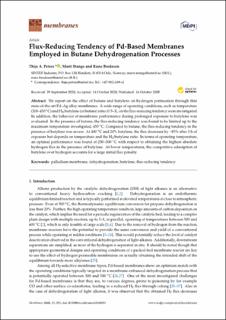| dc.contributor.author | Peters, Thijs | |
| dc.contributor.author | Stange, Marit Synnøve Sæverud | |
| dc.contributor.author | Bredesen, Rune | |
| dc.date.accessioned | 2022-09-19T13:53:22Z | |
| dc.date.available | 2022-09-19T13:53:22Z | |
| dc.date.created | 2021-01-17T10:21:51Z | |
| dc.date.issued | 2020 | |
| dc.identifier.citation | Peters TA, Stange M, Bredesen R. Flux-Reducing Tendency of Pd-Based Membranes Employed in Butane Dehydrogenation Processes. Membranes. 2020; 10(10):291. https://doi.org/10.3390/membranes10100291 | en_US |
| dc.identifier.issn | 2077-0375 | |
| dc.identifier.uri | https://hdl.handle.net/11250/3018972 | |
| dc.description.abstract | We report on the effect of butane and butylene on hydrogen permeation through thin state-of-the-art Pd–Ag alloy membranes. A wide range of operating conditions, such as temperature (200–450 °C) and H2/butylene (or butane) ratio (0.5–3), on the flux-reducing tendency were investigated. In addition, the behavior of membrane performance during prolonged exposure to butylene was evaluated. In the presence of butane, the flux-reducing tendency was found to be limited up to the maximum temperature investigated, 450 °C. Compared to butane, the flux-reducing tendency in the presence of butylene was severe. At 400 °C and 20% butylene, the flux decreases by ~85% after 3 h of exposure but depends on temperature and the H2/butylene ratio. In terms of operating temperature, an optimal performance was found at 250–300 °C with respect to obtaining the highest absolute hydrogen flux in the presence of butylene. At lower temperatures, the competitive adsorption of butylene over hydrogen accounts for a large initial flux penalty. | en_US |
| dc.language.iso | eng | en_US |
| dc.publisher | MDPI | en_US |
| dc.rights | Navngivelse 4.0 Internasjonal | * |
| dc.rights.uri | http://creativecommons.org/licenses/by/4.0/deed.no | * |
| dc.subject | flux-reducing tendency | en_US |
| dc.subject | butylene | en_US |
| dc.subject | dehydrogenation | en_US |
| dc.subject | palladium membrane | en_US |
| dc.title | Flux-Reducing Tendency of Pd-Based Membranes Employed in Butane Dehydrogenation Processes | en_US |
| dc.type | Peer reviewed | en_US |
| dc.type | Journal article | en_US |
| dc.description.version | publishedVersion | en_US |
| dc.rights.holder | © 2020 by the authors. Licensee MDPI, Basel, Switzerland. This article is an open access article distributed under the terms and conditions of the Creative Commons Attribution (CC BY) license (http://creativecommons.org/licenses/by/4.0/). | en_US |
| dc.source.volume | 10 | en_US |
| dc.source.journal | Membranes | en_US |
| dc.source.issue | 10 | en_US |
| dc.identifier.doi | 10.3390/membranes10100291 | |
| dc.identifier.cristin | 1872600 | |
| dc.relation.project | EC/H2020/814671 | en_US |
| dc.source.articlenumber | 291 | en_US |
| cristin.ispublished | true | |
| cristin.fulltext | original | |
| cristin.qualitycode | 1 | |

